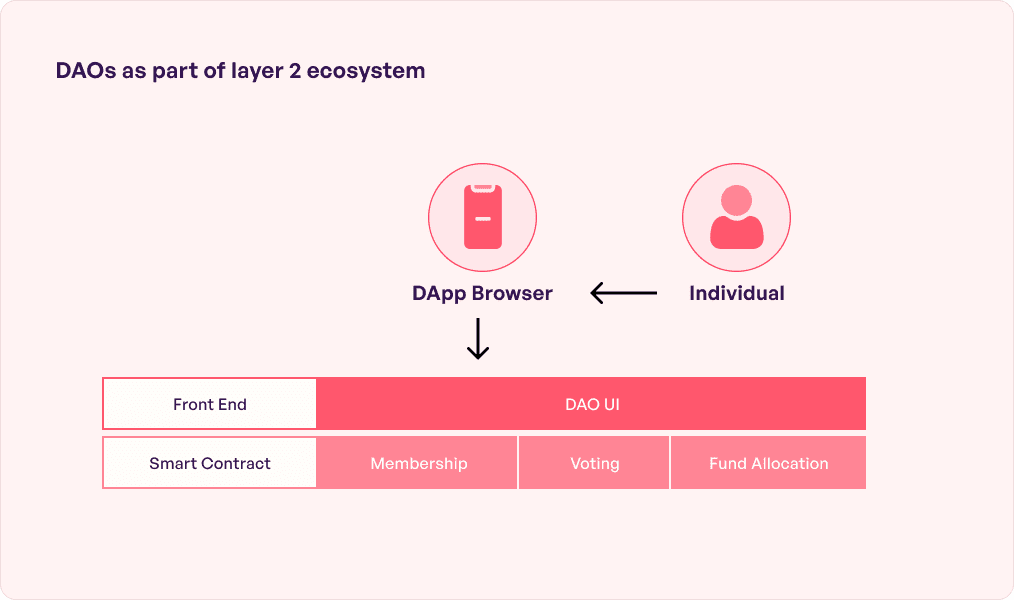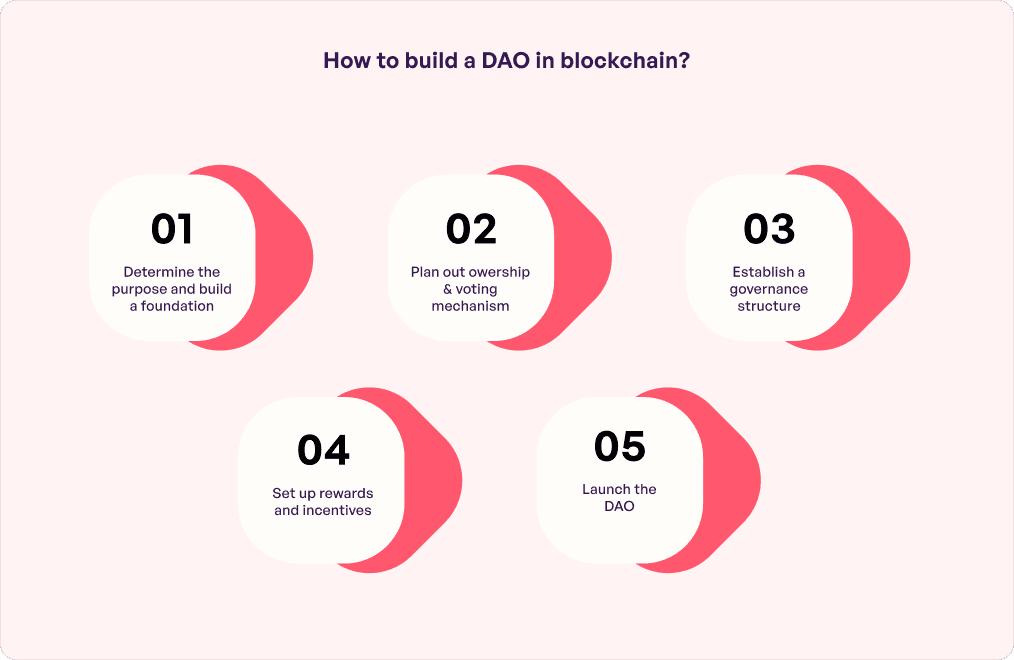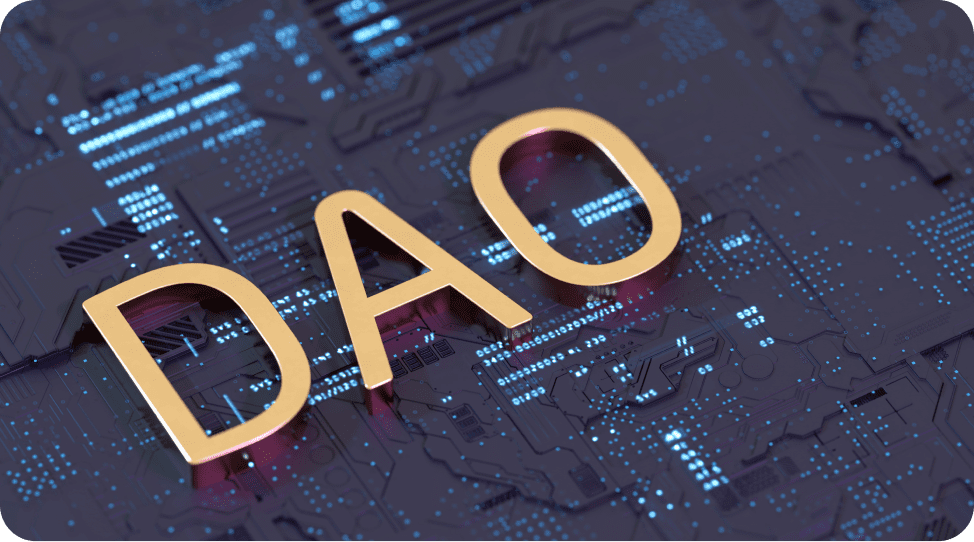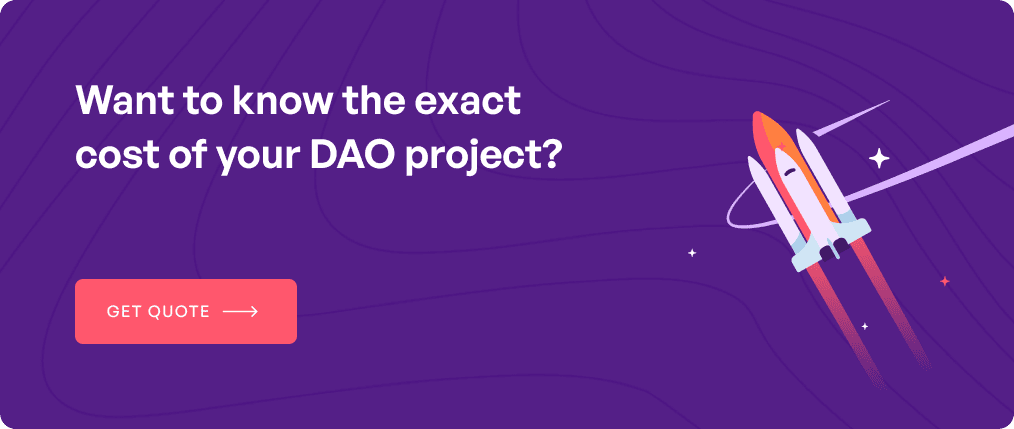Every entrepreneur wants to reach a stage where they form a big business that is equal parts scalable. While ambitious, they end up facing a challenge – one that is shared by every growing business – establishing an effective, democratic governance. After a point in business growth, they face internal governance tensions where the more the participants the more difficult it gets to get to a consensus.
Blockchain technology has found a solution to this problem through DAOs – decentralized autonomous organizations. It is a DeFi project that makes use of distributed ledger technology and smart contracts for executing governance decisions based on voting outcomes. Here’s a high-level view of how DAO platforms work.
- A project gets launched having a defined purpose and specialty.
- The users join the project by buying native coins and getting voting rights in return.
- The community members vote on business decisions with every member having the necessary number of tokens getting the voting right.

Now with something so inherently complex to build and revolutionary, what does a decentralized autonomous organization have to offer that would make it eventually replace the age-old hierarchical format of making decisions?
Table of contents
Traditional organizations vs DAOs
DAOs and traditional organizations are completely different in concept and working. While the former deals with complete decentralization and an emotion-less mode of operation, the latter is more dependent on what individuals’ position in the business.
| Category | Traditional Orgs. | DAOs |
| Organizational structure | Hierarchical | Flat, Democratic |
| Role of voting | Any party can implement changes based on the company’s structure | Mandatory for making any changes to the protocol |
| Governance | Based on board of directors, executives, or active investors | Based on community |
| Transparency | Private and restriction on public involvement | Transparent and fully public |
| Services handling | Requires human handling | Automated |
As you would have gathered by now, DAOs and traditional organizations work with the same end goal – to make decisions easier and free from bias. The only catch is that DAOs make it all easier. With this, it is time to look into the how.
How to build a DAO?
At the core, a DAO development platform consists of four key elements – Governance, Objective, Voting, and Rewards. While we have already covered how the platform works, understanding it to a level where you are involved in creating a DAO would need a detailed step-by-step understanding.

Establish the purpose
The primary stage of answering how to create DAO is identifying why it is necessary, the role it would play, and how it would work. While the discovery workshop session will answer all these questions, on the technical side you will need to plan out a foundation having –
- Encrypted wallet allowing for token storage and transactions
- Smart contracts powering automated processes
- Community of key members
- Specific voting timeline
- Forum or chat room option for members
Plan ownership and voting mechanisms
Once you know the goals to set up when you build a DAO, next comes establishing the ownership and planning out the voting mechanisms. When it comes to transferring ownership, you will typically get three options –
- Airdrops – Tokens are given based on contributions to the community
- Rewards – Payments made to members who achieve their duties
- Token purchase – List tokens on decentralized exchanges
Now as for the voting mechanisms, a popular way is to decide the votes based on the number of tokens. The side that has maximum tokens will get to call the final shot.
Build the governance structure
This phase of when you create a DAO deals with detailing the decisions that will be made after the DAO has been set up. It will also have information on processes’ use cases, voting mechanisms, and clarity on the DAO’s essential components, such as –
- The exchange that will hold the transactions
- Developers who will work on the code
- Validator who will verify the transactions
- Users who will participate in the community
- How will the DAO make money – the sale of native tokens or investors’ shares in return for their investments in an early-stage project
Set up incentives or rewards
The last stage of building DAO in blockchain is setting up a rewards system for the DAO members to pay in turn for their contributions. Usually, the governance tokens are distributed to the contributors who use the DeFi protocol and represent the ownership rights that they carry. The members can also be rewarded through cryptocurrencies, grades, titles, or a combination of them.
Token creation and allocation
Once every goal, governance rule, and incentive system is in place, concentrate on how the DAO tokens would work. Noting how the tokens would decide the voting rights, you should have tokenomics in place which would clearly explain the token’s purpose, their allocation, how they would affect supply, etc.
Now that we have looked at what is DAO and what are the different steps you would need to take to answer how to create DAO, let us get down to the one question that we are sure you must be asking – what would be the cost to start a DAO?
Let’s answer that in a bit after looking into the technology stacks that would help you build the DAO and then launch it in the market.
Technology stacks for building and launching a DAO
| Frameworks | Colony, OPENLAW, DAOstack, and Syndicate |
| Contribution and reputation | GITCOIN, SourceCred |
| Frontend & analytics | Tally and DeepDAO |
| Treasury management | Parcel, Multi safe , Gnosis Safe |
| Compensation | OPOLIS, Sablier, Superfluid |
| Governance and voting | Snapshot, Paladin, Tally |
| Access | MintGate, Unlock, Collab.Land |
| Discussion | Discord, Telegram, Twitter |
| Identity | IDX, ENS |
| Databases | The Graph, CouchDB |
| Programming language | Solidity, Vyper, Rust, Python, C++ |
| Smart contracts | Truffle, OpenZeppline, HardHat, Infura, Alchemy |
| Wallets | Binance, Trust Wallet, Meta Mask, Coinbase |
| Launch platforms | DAOhaus, Collab.Land, Aragon |
These technology sets when added with the type of DAO you wish to create and its specific features would ultimately decide the cost of your DAO blockchain development solutions. As we conclude the article, let us give you a peek into what to expect when it comes to deciding the cost range you wish to spend on the project.
What would be the cost of a DAO project?
The cost of DAO project, as we discussed above, would primarily depend on a mix of – type and its features, technology stack, and the blockchain platform you choose.
Additionally, here are some costs you will have to keep a note of.
- The DAO setup cost on Aragon and DAOstack Alchemy is 2ETH.
- Registering DAO as LLC would cost somewhere around $100.
- You’ll need to hire a blockchain app development services company to create an internal token (ERC-20) and generate its supply, voting system with consistent smart contract logic and a safe functioning.
- DAO smart contract audit
- The DAO should also have a platform for member communication and essential news updates.
With this, we have looked into every aspect of DAOs – the information you would need to initiate your project with confidence.
This is the stage where you partner with a blockchain development agency that doesn’t just understand your project’s concept but also has an experience in converting complex blockchain projects into solutions that have a mass usage. Enter Simublade.
At Simublade, we have a dedicated blockchain R&D division that runs hypothesis tests on different decentralization-focused use cases including DAO. We are prepared to work on your project with the right tech expertise and team. Share your idea with us today.
FAQs
Q. How does DAOs work?
A. A Decentralized Autonomous Organization (DAO) operates on the principles of blockchain technology, embodying decentralized decision-making and governance.
In a blockchain DAO, smart contracts facilitate the organization’s functions. The participants hold tokens that represent their voting power, enabling them to propose and vote on decisions, such as changes to the protocol or allocation of funds. These proposals are executed automatically through smart contracts if they meet the predefined criteria.
Q. How can DAOs be used?
A. Decentralized Autonomous Organizations offer a versatile framework for collaborative decision-making and resource management. They can be employed across various industries and applications, ranging from governance and finance to art and gaming.
- In governance, they enable communities to collectively steer the direction of projects or protocols, fostering a democratic approach to decision-making.
- In the financial sector, DAOs provide a transparent and decentralized way to manage funds, enabling trustless transactions and reducing reliance on traditional intermediaries.
- Additionally, DAOs can revolutionize the creative industries by allowing artists to collaboratively govern digital assets and distribute rewards based on community input.
Q. What are some common types of DAOs?
A. Some common types of DAOs include –
- Governance DAO: MakerDAO
- Funding DAO: The DAO (though it faced issues and resulted in a fork leading to Ethereum and Ethereum Classic)
- Collective Ownership DAO: ConstitutionDAO
- Decentralized Venture Capital DAO: MetaCartel Ventures
- Decentralized Autonomous Exchange (DEX DAO): Uniswap Governance
- Decentralized Autonomous Nonprofit: Gitcoin Grants DAO
Q. How much does it cost to build a DAO project?
A. There is no fixed way to answer this question. The cost to form and then launch a DAO would depend entirely on the type of DAO project you choose and its specific feature sets, the technology stack it will be built on, and the blockchain platforms you will be using.





